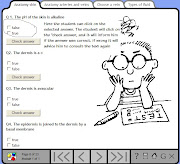That's life.....
Wednesday, July 29, 2009
Hallo to all
If you have used this before, will you please share your experiences and tips with us novices? As I uncover its secrets I will keep you updated on my progress and setbacks. For know, I am keen to see my project evolving into something useful.
Till later...
Estelle
Tuesday, July 21, 2009
Something helpful..
Hi to all
As you can see, I am using my Google Reader to keep me updated. I found this site informative and concise. Perhaps it can be of use to us.
Estelle
Monday, July 20, 2009
On patient safety...
I have found the above article of particular interest for those of us that work and teach in the critical care environment. Although this does not have direct relevance to what this blog is about, it certainly impacts on patient safety on a day to day basis.
I will focus my e-learning event on the clinical skill of commencing an intravenous infusion as well as administering intravenous medication. This skill is required from nurses and medical personnel alike and is taught in the 2nd year of the nursing curriculum, and the 3rd year of the medical curriculum. Maintaining competence is a matter of practice and self-confidence. Clinical follow-up and facilitation post-skills lab training is very important if we would like our students to safely master this skill.
Until later...
Estelle
Sunday, July 12, 2009
My project
- Aseptic hand wash
- Donning on sterile gloves
- Taking a patients Blood pressure, pulse, respiration and temperature
- Draw venous blood
The procedures are discussed with the students and they are allowed to practice the procedures in the CSC under supervision of the clinical educator. They are encouraged to return to the CSC as often as they like to practice. They also get a booklet with the theory supporting the procedures, which they can use as a guide when practicing.
The 3rd year students follow a similar program for the following procedures:
- Insertion of an intravenous catheter
- Taking an arterial blood sample
- Inserting a nasogastric tube
- Suturing
- Administering an intramuscular injection
Fourth year students are taught inhaler technique, examining the ear etc. I spoke with on of the 3rd year students on Friday and was amazed to find that he has not had the opportunity to practice many of the procedures following the initial teaching and learning sessions. The students are exposed to formative and summative assessment of these procedures. The reality is that many of them have not yet performed these procedures on real patients by the time they get evaluated. As they progress to their fourth and fifth year of study more and more demands are placed on their skills and knowledge, and these basic procedures fall by the wayside.
The initiative to set up a website and to produce learning material that will be accessible to the student in the work environment was suggested to support clinical skills training. The material, once available on CD-ROM, can also be used by students placed in the rural rotations where access to internet may be problematic. As was discussed at the recent SAAHE conference the concept of creating open educational resources is becoming an accepted approach to teaching and learning. One has only to look at the vast amount of learning material available on internet to realise that information is at our fingertips, no longer contained in the books and minds of educated people. It is out there, available to anyone who wishes to explore the world wide web.
But, there is one problem... We live in Africa. Resource constraints, inadequate band width, language barriers, to name but a few, are challenges that students and registrars placed in the rural areas of South Africa face on a day to day basis. Just establishing a website may therefor not be enough as it will only allow students with access to computers and internet the opportunity to utilize the resource. Putting the learning material on CD may therefor add value by allowing the student to access the material from any computer with a CD reader. The format in which material will be saved would be important as computers in rural areas may not have the latest software installed.
Some work has already been done on creating learning material that would be published on the website, but that would also be available on a CD. As you can imagine the production of DVD's is no simple task. Acquiring the expertise to jump start the project was just one of the many challenges we faced thus far. Thankfully there was money available to buy a video camera and to pay the people involved in recording the practical demonstrations on the video camera. As none of us had the expertise to merge the recorded material with the written text of the procedure, an expert had to be bought in to teach us how it is to be done.
I am not sure how many clinical procedures we have successfully put together thus far. In my next discussion I will share with you the challenges we faced thus far and what we did to overcome them. I will also refer you to very useful websites I have used to help me in writing the text for the procedures.
I welcome your comments and suggestions should you have any.
Keep well until next time.
Estelle
Thursday, July 9, 2009
Last module for the MPhil in HSE
Look out for my next post... I will try to make it interesting and educational at the same time.

